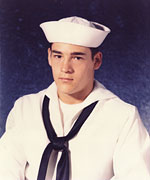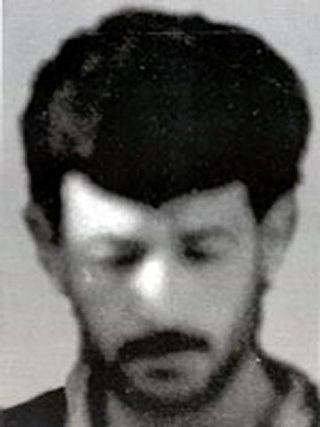
Trans World Airlines (TWA) was a major American airline which operated from 1930 until 2001. It was formed as Transcontinental & Western Air to operate a route from New York City to Los Angeles via St. Louis, Kansas City, and other stops, with Ford Trimotors. With American, United, and Eastern, it was one of the "Big Four" domestic airlines in the United States formed by the Spoils Conference of 1930.
This is a list of aviation-related events from 1985.

Robert Dean Stethem was a United States Navy Seabee diver who was murdered by Hezbollah terrorists during the hijacking of the commercial airliner he was aboard, TWA Flight 847. At the time of his death, his Navy rating was Steelworker Second Class (SW2). He was posthumously promoted to Master Chief Constructionman (CUCM).

Ali Atwa was a Lebanese national and member of the Islamist organization Hezbollah. Atwa was also known as Ammar Mansour Bouslim and Hassan Rostom Salim.

Hasan Izz-Al-Din is a Lebanese national wanted by the United States government.
In December 1973, a Palestinian terrorist group executed a series of attacks originating at Rome-Fiumicino Airport in Italy which resulted in the deaths of 34 people. The attacks began with an airport-terminal invasion and hostage-taking, followed by the firebombing of a Pan Am aircraft and the hijacking of a Lufthansa flight.

Uli Derickson, was a German American flight attendant best known for her role in helping protect 152 passengers and crew members during the June 14, 1985, hijacking of TWA Flight 847 by militants with alleged links to Hezbollah.

The Delta Force is a 1986 American action film starring Chuck Norris and Lee Marvin as leaders of an elite group of Special Operations Forces personnel based on the real life U.S. Army Delta Force unit. Directed, co-written and co-produced by Menahem Golan, the film features Martin Balsam, Joey Bishop, Robert Vaughn, Steve James, Robert Forster, Shelley Winters, George Kennedy, and an uncredited Liam Neeson in an early role. It is the first installment in The Delta Force film series. Two sequels were produced, entitled Delta Force 2: The Colombian Connection and the direct-to-video Delta Force 3: The Killing Game. The Delta Force was "inspired" by the hijacking of TWA Flight 847.

The following events occurred in June 1985:

Mohammed Ali Hammadi, also known as Mohammed Ali Hamadi is one of the list of FBI's Most Wanted Terrorists most notable for being the lead hijacker in the TWA Flight 847 hijacking. A Lebanese citizen and alleged member of Hezbollah, he was convicted in a West German court of law of air piracy, murder, and possession of explosives for his part in the 14 June 1985 hijacking of TWA Flight 847.
Fawaz Younis, also known as Fawaz Yunis and Nazeeh, is a Lebanese hijacker who was arrested in international waters pursuant to an arrest warrant issued in the United States. He was transported to the US and convicted; he was sentenced to 30 years. He was later deported after serving sixteen years of his sentence.

The Taking of Flight 847: The Uli Derickson Story(also known as The Flight) is a 1988 American made-for-television drama film based on the actual hijacking of TWA Flight 847 as seen through the eyes of flight purser Uli Derickson, the chief flight attendant. Derickson herself acted as a consultant for the film. The film was directed by Paul Wendkos and showcases the first 48 hours of the hijacking until Derickson's liberation.
The 1983 Kuwait bombings were attacks on six key foreign and Kuwaiti installations on 12 December 1983, two months after the 1983 Beirut barracks bombing. The 90-minute coordinated attack on two embassies, the country's main airport, and petro-chemical plant was more notable for the damage it was intended to cause than what was actually destroyed. What might have been "the worst terrorist episode of the twentieth century in the Middle East" killed only six people because of the bombs' faulty rigging.
The Lebanon hostage crisis was the kidnapping in Lebanon of 104 foreign hostages between 1982 and 1992, when the Lebanese Civil War was at its height. The hostages were mostly Americans and Western Europeans, but 21 national origins were represented. At least eight hostages died in captivity; some were murdered, while others died from lack of adequate medical attention to illnesses. During the fifteen years of the Lebanese civil war an estimated 17,000 people disappeared after being abducted.
The Jibril Agreement or "Jibril Deal" was a prisoner exchange deal which took place on May 21, 1985 between the Israeli government, then headed by Shimon Peres, and the Popular Front for the Liberation of Palestine - General Command. As part of the agreement, Israel released 1,150 security prisoners held in Israeli prisons in exchange for three Israeli prisoners captured during the First Lebanon War. This was one of several prisoner exchange agreements carried out between Israel and groups it classified as terrorist organizations around that time.

Kuwait Airways Flight 422 was a Boeing 747 jumbo jet hijacked en route from Bangkok, Thailand, to Kuwait City, Kuwait on 5 April 1988, leading to a hostage crisis that lasted 16 days and encompassed three continents. The hijacking was carried out by several Lebanese guerillas who demanded the release of 17 Shi'ite Muslim prisoners being held by Kuwait for their role in the 1983 Kuwait bombings. During the incident the flight, initially forced to land in Iran, traveled 3,200 mi (5,100 km) from Mashhad in northeastern Iran to Larnaca, Cyprus, and finally to Algiers.
From 1985 to 1986, a series of terrorist attacks in Paris, France was carried out by the Committee for Solidarity With Arab and Middle Eastern Political Prisoners (CSPPA), a previously unknown group, demanding the release of three imprisoned international terrorists. The CSPPA was believed to have been some combination of Palestinians, Armenian nationalists, and Lebanese Marxists, though it was later reported that they were mainly instigated by Hezbollah, sponsored by the Iranian state. The CSPPA demanded the release of Anis Naccache, from the Iranian state network; Georges Ibrahim Abdallah, member of the Lebanese Armed Revolutionary Factions (LARF); and Varadjian Garbidjan, member of the Armenian Secret Army for the Liberation of Armenia (ASALA).
Benjamin Christian Zimmerman is an American pastor, former politician, retired United States Air Force pilot, and commercial pilot from Idaho. Zimmerman was a Republican member of Idaho House of Representatives.
The 1973 Hellinikon International Airport attack was an attack at the Hellinikon International Airport at Athens, Greece. The two attackers were members of the Palestinian militant organization Black September. The militants used sub-machine guns and grenades against the passengers waiting in the passenger lounge. The attackers took hostages before they finally surrendered to the Greek police. It is believed that the gunmen wanted to hijack a plane, but they decided to attack when they were about to be searched by a Greek security inspector before boarding.













